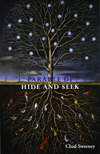Parable of Hide and Seek
Chad Sweeney’s Parable of Hide and Seek reads like the experience of stepping into someone else’s bizarre but magnificently imaginative dreamworld. In Sweeney’s world, deserts have doors and rats swim to the sun, calling to mind a surrealist painting. There exists also a prevailing wariness about the deceptive nature of cities, and the oddness of various geographical landscapes, which can be paralleled only in the absurdity of language. Sweeney’s occasional wordiness is offset by language that is frequently tight and beautiful, replete with analogies that stick with us long after we have moved on, or easily evoke a chuckle in their cleverness: “My wife screamed backwards / which sounded like a bear trap / not going off.” Bordering on esoteric at times, Sweeney also grounds us with poignant images of human futility, as in “A Love Song”:
Because a man drowning
in a grain silo
in the deep golden flax
thinks only of the note
in his back pocket
that will not be given.
But then, as we can count on with Sweeney’s gift for the tantalizing push-and-pull, the book’s historical and sociocultural explorations lend it an air of human connectedness, like the hangman disappointed by the results of his elementary school personality test. Ultimately, Parable of Hide and Seek is a mesmerizing read that takes the unexpected to a new and unchartered level.





